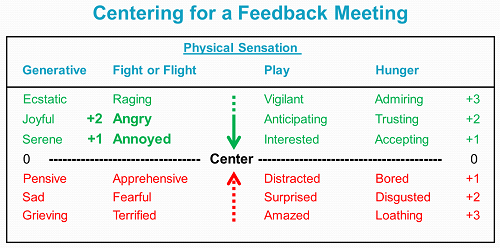When you walk in the room, who shows up for Read more →
Getting to the Center of an Emotional Storm
Posted Friday, September 21, 2012Allen Slade
The oddest thing about hurricanes is the calm at the center of the storm. Pelting rain and destructive winds depart. The wind is calm and the sun is shining. You know the eye won’t last, but you can take a break, step outside, do a quick check and plan how to face the rest of the storm.
Sometimes our emotions swirl like a storm. Today’s post focuses on how leaders can calm their emotions through centering. This is step four of managing emotions:
- “How am I feeling?”
- “How are my emotions serving me right now?”
- “Would different emotions (type or intensity) serve me better?”
- “How do I get there?”
For example, in a feedback meeting with a difficult employee, your fight sensation might be activated. You and your employee would be better served if you have less intense emotions. On the emotional scale below, you don’t want be so intense that you are angry (+2). However, annoyed (+1) would serve you well.
If you decide your emotions are too intense, then how can you move closer to the center? How can you create an eye in an emotional storm?
You can create emotional calm with centering. By focusing your thoughts and calming your body, you can reduce the intensity of your emotions. I use a centering exercise with my clients that takes about five minutes. It can lower your heart rate, reduce your blood pressure and (most importantly) reduce the intensity of your emotions.
You center to reduce your emotional intensity, not to totally bury your emotions. In that feedback meeting with your difficult employee, being completely serene won’t work. You care about performance and you expect to see a change. You want to experience annoyance rather than anger or rage. In general, at work we want emotional intensity of -1 to 1. Emotions at intensity level 2 could be career limiting, except at farewell parties and new product launches.
What if you are in the middle of a meeting when your emotions kick in? It is not possible to close your eyes for five minutes, so you need other tactics to center your emotions.
If someone else is talking, you can center in your chair, Modify your full-length centering exercise so it is shorter. Then, mentally check out of the meeting for 30-60 seconds. Staying seated with your eyes open, run through your routine. Here is one way to center in your chair.
If you are in the spotlight – it is your speech or you have just been called on – you can’t leave for five minutes or check out for 30 seconds. Then, your best move can be to center in the moment by taking a deep breath, touching your touchstone or making a silent declaration.
Breathing. All three exercises – centering, centering in your chair and centering in the moment – involve breathing. Taking a deep, controlled breath oxygenates your blood. This helps lower your pulse, blood pressure and adrenaline. It also establishes, at a visceral level, that you are in control. If one breath doesn’t center you enough, do two more.
Touchstone. A touchstone or totem is something you carry with you to remind you of your purpose and passion. It should have some personal meaning to you. I touch my signet ring. My ring has a custom symbol that reminds me of the important areas of my life – faith, family, friends and work. When I touch it, I remember who I am and what I am about. Your touchstone could be a piece of jewelry, a small stone, or any item that is convenient. The key is that your touchstone should be meaningful to you and should be on you whenever you might face an emotional storm.
Declaration. A centering declaration is a brief, silent statement about your purpose and identity in the form of “I am …” or “I will …” The nature of declarations will be the topic of my next post.
Managing your emotions puts you in charge. You identify your feelings and then deliberately moderate your feelings to serve you and the people around you. Even when your situation is emotionally fraught, you can manage your emotions. You can find the calm you need in the midst of an emotional storm.



Great tips especially the idea of having a totem. I would also recommend to use some drops of essential oil on a tissue that you can also use at night before you go to sleep with deep breathing. The olfactory regions of the brain do not only serve for smelling, but are stimulated when we experience emotions and memorizing.
Pingback: Practicing Leadership Skills in Safety